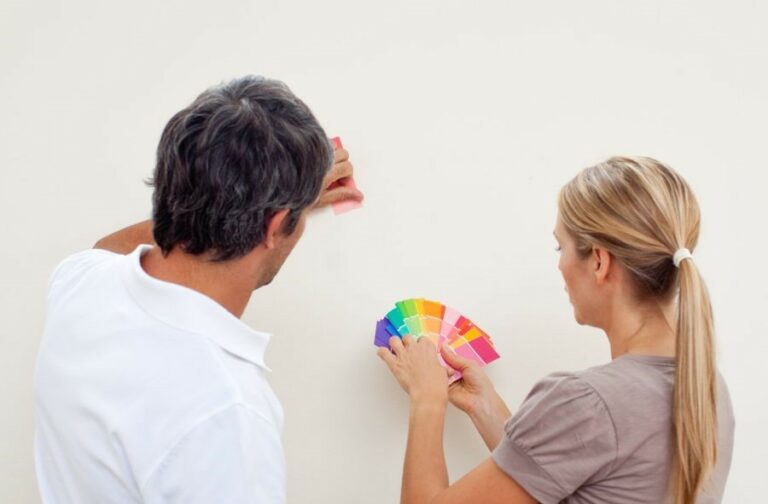Matte vs. Glossy Acrylic Wall Paint, 25 Things You Should Know
Planning to give your walls a fresh look? Let’s discuss the two top contenders in acrylic wall paint: matte and glossy. Both have unique appeal and serve different purposes, but which suits your vision best? Worry not; we’ve got you covered. Well delve into their characteristics, compare their pros and cons, and help you make the best choice for your home.
Matte vs. glossy acrylic wall paint:
Matte acrylic wall paint, known for its non-reflective finish, is ideal for hiding surface imperfections and creating a cozy atmosphere in living rooms, bedrooms, and hallways. Glossy acrylic wall paint, with its shiny and reflective appearance, is highly durable and suitable for high-traffic areas like kitchens and bathrooms. To achieve a balanced aesthetic, consider combining matte walls with glossy trim.

Confused between matte and glossy acrylic wall paint for your space? Delve deeper into their unique characteristics, pros, cons, and ideal applications for each finish. Read on to make an informed decision that suits your style and requirements perfectly!
Contents
- 1 Matte vs. Glossy: Choosing Acrylic Wall Paint Finishes
- 2 Which wall finish prevails? Matte or Glossy?
- 3 Deciding between Matte and Glossy for Acrylic Art
- 4 Selecting the Ideal Paint Finish for Interior Walls
- 5 Favoring Matte Finish for Wall Paint: Is it Best?
Matte vs. Glossy: Choosing Acrylic Wall Paint Finishes
When considering a new painting project, one of the biggest decisions is choosing between matte and glossy acrylic wall paint finishes. Both options have their own unique benefits and drawbacks, and selecting the correct finish can greatly impact the final look of your room.
• Characteristics of Matte Acrylic Wall Paint
Matte acrylic wall paint is characterized by its non-reflective, velvety finish. It is a popular choice for a variety of spaces due to its ability to hide surface imperfections and create a soft, cozy atmosphere.
– Pros
- Hides Surface Imperfections: Matte paint is excellent for masking small flaws and uneven textures, making it ideal for use on older or imperfect walls.
- Minimizes Visual Distractions: The non-reflective nature of matte paint reduces glare, preventing the eye from being drawn to any inconsistent areas.
- Easy Touch-Ups: When future touch-ups are needed, matte paint blends more easily without creating an obvious outline around the new paint.
- Aesthetically Versatile: Matte paint can be used in a range of interior styles, from modern minimalist to classic and traditional.
– Cons
- Less Durable: Matte paint may be more prone to scuffs and stains and can be more challenging to clean without damaging the finish.
- May Require More Coats: Depending on the color and wall surface, matte paint can sometimes require multiple coats for full coverage.
• Characteristics of Glossy Acrylic Wall Paint
Glossy acrylic wall paint is known for its shiny, reflective appearance. This finish is commonly used in areas with high foot traffic and moisture, such as kitchens and bathrooms, and can add a vibrant and polished look to your space.
– Pros
- Highly Durable: Glossy paint is more resistant to stains, scuffs, and moisture, making it an excellent choice for high-traffic or high-moisture areas.
- Easy to Clean: The smooth surface of glossy paint allows for quick and easy wipe-downs without damaging the finish.
- Reflects Light: The reflective surface of glossy paint can help brighten darker spaces and create a feeling of spaciousness in smaller rooms.
– Cons
- Highlights Surface Imperfections: Glossy paint’s reflective nature can emphasize uneven textures and small flaws on wall surfaces.
- More Challenging Application: Glossy paint can be trickier to apply evenly, as it is more prone to showing brush or roller marks.
• Expert Recommendations: When to Use Matte or Glossy Acrylic Wall Paint
Based on our experience, we recommend the following considerations when deciding between matte and glossy acrylic wall paint:
- Use Matte Paint for Living Rooms, Bedrooms, and Hallways: The subtle and soft finish provided by matte paint is an excellent choice for spaces where relaxation and comfort are prioritized. Additionally, its ability to hide imperfections makes it a popular option for larger wall spaces.
- Choose Glossy Paint for Kitchens, Bathrooms, and Trim: Given its durability and resistance to moisture, glossy paint is an ideal choice for areas with high foot traffic and potential water exposure. Glossy finishes also add visual interest when used on trim, molding, and doors.
- Consider a Combination: In some cases, a combination of matte and glossy paint can create a balanced and dynamic aesthetic. For example, using matte paint on walls and glossy paint on trim can add depth and contrast to your space.
- Sample Swatches: To ensure the best possible result, we recommend testing swatches of both matte and glossy paint options in your desired color on the wall surface you plan to paint. This will allow you to see how each finish interacts with the specific lighting and texture of that area. The U.S. Federal Citizen Information Center provides helpful guides and tips for homeowners embarking on painting projects.
By taking into consideration the unique advantages and drawbacks of matte and glossy acrylic wall paint, you can make an informed choice that best suits the needs of your specific space.
Armed with this knowledge, you are one step closer to creating a beautiful and personalized room that perfectly reflects your style and taste.
Which wall finish prevails? Matte or Glossy?
Many homeowners are constantly looking for ways to make their living spaces look better and more unique. One easy way to achieve this is by paying attention to the type of paint finish used on walls.
The finish of the paint can have a significant impact on the overall appearance of your home. Two of the most popular paint finishes are glossy and matte, but which one is the better option for your walls?
• Glossy Finish: Pros and Cons
– Benefits of Glossy Walls
- Durability: Glossy paint is known for its durability and resistance to wear and tear. It can withstand frequent cleaning and scrubbing without showing signs of damage, making it ideal for high-traffic areas like hallways, kitchens, and bathrooms.
- Light Reflectivity: Glossy surfaces reflect light, helping to brighten up rooms and create an illusion of more space. This property is particularly useful in smaller, darker spaces with limited natural light.
- Vibrant Colors: Glossy paint tends to make colors appear more vivid and saturated, giving your walls an eye-catching and lively appearance.
– Drawbacks of Glossy Walls
- Surface Imperfections: Glossy paint is notorious for highlighting every bump, crack, and imperfection on walls. This means that you might need to invest more time and effort in preparing and priming the surfaces before applying the glossy finish.
- Cost: Glossy paint finishes are generally more expensive than their matte counterparts. This is because they tend to require multiple coats to achieve consistent and even coverage.
- Limited Options: Glossy finishes may not be suitable for all interior design styles. For instance, in modern minimalist or Scandinavian-inspired interiors, matte finishes often work better to create a calm and understated look.
• Matte Finish: Pros and Cons
– Benefits of Matte Walls
- Hiding Imperfections: Matte paint does a great job at hiding minor surface flaws, making it ideal for older walls that may have developed cracks or uneven textures over time.
- Soft Appearance: Matte finishes offer a soft, non-reflective surface that can create a sense of warmth and coziness in a room. This can be especially appealing in bedrooms and living areas where comfort is important.
- Versatility: Matte paint complements a wide range of interior design styles, making it a popular choice for many homeowners.
– Drawbacks of Matte Walls
- Maintenance: Matte paint tends to be more susceptible to marks, stains, and scuffing than glossy surfaces. While these imperfections can be cleaned, frequent or vigorous scrubbing can damage the paint’s appearance.
- Color Saturation: Matte finishes do not have the same vibrancy and color saturation as glossy paints. As a result, the colors on matte walls may appear more subdued and muted.
- Dark Rooms: Matte paint does not reflect light, which can make a room feel darker and smaller. This may not be ideal for rooms that already lack natural light and spaciousness.
• Making the Right Choice for Your Walls
Ultimately, the choice between glossy and matte finish for your walls depends on your personal preferences, the specific room’s function, and your overall interior design style.
For instance, in high-traffic areas such as kitchens, bathrooms, or playrooms, a glossy finish might be more suitable due to its durability and easy maintenance. In rooms where creating a relaxing and cozy ambiance is desired, such as bedrooms or living rooms, a matte finish would be more appropriate.
When in doubt, I recommend testing both finishes in small areas of your home to observe the differences in appearance and practicality. This can help you make an informed decision on which finish will best suit your needs and preferences.
For further assistance in choosing the right paint finish for your walls, consult resources from reputable organizations like The American Coatings Association or The Painting and Decorating Contractors of America.
These organizations provide guidance and expertise on paint finishes and can help you choose the right one for your walls.
Deciding between Matte and Glossy for Acrylic Art
When it comes to choosing between matte and glossy finishes for acrylic painting, artists often face a dilemma. Both of these finishes possess their pros and cons that need to be considered before deciding which one is the best fit.
• Matte Finish: Properties and Benefits
A matte finish is characterized by a non-reflective, flat, and smooth surface. This type of finish is ideal for reducing glare and adding depth to a painting. Below are some of the benefits of using a matte finish for acrylic painting:
– Less Glare
One of the main advantages of a matte finish is that it does not reflect light directly, creating less glare on the painting surface. This makes it easier to view the artwork in different lighting conditions, such as under direct sunlight or artificial light sources.
– Enhanced Color Depth
A matte finish can help to enhance the depth of colors in a painting, especially darker shades. This is because matte surfaces absorb light rather than reflecting it off the surface, making the colors appear more saturated and rich.
– Greater Detail Visibility
Matte finishes also offer better detail visibility, as the lack of surface reflection allows the viewer to focus on the textures and intricate details present in the artwork. This is particularly beneficial for realistic and detailed paintings.
– Better Clarity for Photographing Artwork
If you plan to photograph your artwork for portfolios, websites or print materials, matte finishes can provide better clarity than glossy finishes. The absence of glare and reflections on the surface of the painting can result in cleaner, sharper images.
• Matte Finish: Disadvantages
Despite the benefits of matte finishes, there are also certain drawbacks to consider, such as:
– Reduced Vibrancy for Some Colors
Some artists may find that certain colors, particularly lighter hues, may appear less vibrant on a matte surface compared to a glossy one. This is because the matte surface absorbs more light, resulting in a less vibrant appearance.
– Vulnerability to Surface Scratches
Matte finish surfaces can be more prone to scratches and scuffs in comparison to their glossy counterparts. This is because matte finishes lack the protective, reflective layer found on glossy surfaces.
– Higher Maintenance
Matte finishes can require more maintenance compared to glossy finishes, as they may be more susceptible to dirt, dust, and fingerprints. With no protective layer to shield the surface, additional care is necessary to ensure the artwork remains clean and undamaged.
• Glossy Finish: Properties and Benefits
Glossy finishes for acrylic paintings are known for their high shine and reflective qualities. Here are some of the benefits associated with using a glossy finish:
– Enhanced Visual Vibrancy
Due to their light-reflective properties, glossy finishes can make colors appear more vibrant and visually striking. This is particularly true for bright and bold hues, as well as metallic and iridescent paints.
– Protection Against Scratches
Glossy surfaces have a protective, reflective layer, which can help to protect the painting from surface damage, such as scratches and scuffs, better than matte surfaces.
– Easier Maintenance
As glossy finishes have a natural protective layer, they can be easier to maintain compared to matte finishes. They are less likely to collect dust and dirt and can be more forgiving when it comes to fingerprints and other superficial marks.
• Glossy Finish: Disadvantages
Despite the advantages of glossy finishes, there are also some inherent drawbacks that need to be considered:
– Increased Glare and Reflections
The reflective surface of a glossy finish can produce glare and reflections, making it difficult to view the artwork in certain lighting conditions or from specific angles.
– Reduced Visibility of Fine Details
The reflective nature of glossy surfaces can also make it difficult for the viewer to focus on the fine details present in the artwork. This can negatively impact the overall perception of realistic and detailed paintings.
– Potentially Overwhelming Shine
In some cases, a glossy finish may be too visually overwhelming, especially when used with an already bold or visually intense painting. It can detract from the artwork itself, diverting attention from the intended focus.
• Personal Recommendations
Based on personal experience, I recommend, in general, a matte finish for intricate and detailed paintings where color depth and detail visibility are crucial, while a glossy finish may be more fitting for bright, bold, and abstract paintings where vibrancy and visual impact are the main focuses.
Ultimately, the choice between matte and glossy finishes for acrylic painting is subjective and depends on the desired effect, the specific artwork, and the artist’s preferences.
In order to make an informed decision, I suggest experimenting with acrylic mediums and varnishes that offer different finishes on sample paintings or color swatches. This will help you determine which finish works best for your particular style and artwork.
In conclusion, neither matte nor glossy finishes are universally better for acrylic painting. Each finish has its advantages and disadvantages, and the best choice depends on the specific artwork and the artist’s preferences.
Experimenting with different finishes and evaluating the results in various lighting conditions can ultimately help you choose the ideal finish for your acrylic paintings.
Selecting the Ideal Paint Finish for Interior Walls
When it comes to choosing the right paint finish for your interior walls, it can be overwhelming with the variety of options available. Factors that should be considered include the room’s purpose, its occupants, and the likelihood of the area being prone to moisture, stains, or scratches.
• Understanding Different Types of Paint Finishes
There are five main types of paint finishes, each with its own unique properties that make them suited for different interior wall applications.
– Flat or Matte Finish
A flat or matte finish is a non-reflective paint finish that hides imperfections well, making it an excellent choice for older walls with blemishes or uneven surfaces. It provides a soft, elegant look that works well in living rooms, bedrooms, and other low-traffic areas.
However, due to its low durability and difficulty to clean, it’s not recommended for high-traffic areas, moisture-prone rooms, or walls that are frequently touched.
– Eggshell Finish
Slightly more reflective than flat or matte finishes, eggshell finish has a low sheen that gives walls a subtle, velvety appearance. It is more durable and easier to clean than matte finishes, making it suitable for moderate-traffic areas such as living rooms, hallways, and bedrooms.
This finish is also a great option for covering uneven wall surfaces because it’s not as revealing as other sheen levels.
– Satin Finish
With a smooth, silky appearance, satin finish is a popular choice for high-traffic rooms due to its good durability and ease of cleaning. It is an ideal choice for family rooms, children’s bedrooms, hallways, and kitchens.
However, it’s important to note that a satin finish may highlight wall imperfections, so proper wall preparation is essential before applying this finish.
– Semi-Gloss Finish
A semi-gloss finish has a higher sheen than satin finishes, making it more reflective and durable. This finish is exceptionally easy to clean, and it’s resistant to stains, moisture, and mildew. It’s a great option for rooms that are prone to humidity or moisture, such as bathrooms or kitchens.
Keep in mind that this finish will show more imperfections on the wall, so preparation is key.
– Gloss Finish
Gloss finishes are the most reflective and durable out of all paint finishes, providing a shiny, mirror-like appearance. This finish is best suited for trim, doors, and cabinets rather than interior walls.
Although it offers excellent resistance to stains and moisture, it can highlight flaws in the surface, requiring extra attention to wall preparation.
• Choosing the Best Paint Finish for Your Rooms Purpose
Different paint finishes work better in specific rooms based on factors like traffic, humidity levels, and wear and tear. Consider the room’s purpose before selecting a paint finish.
– Low Traffic Areas
For rooms that receive minimal traffic, such as guest rooms, living rooms, or formal dining rooms, choose a matte, eggshell, or satin finish. These finishes offer an elegant appearance and are suitable for areas that are not prone to dirt, moisture, or other wear and tear.
– High Traffic Areas
Rooms that see a lot of foot traffic or frequent touching, such as hallways, family rooms, or children’s bedrooms, require more durable and easy-to-clean paint finishes. A satin or semi-gloss finish is ideal for these areas.
– Moisture-Prone Areas
Rooms exposed to humidity or moisture, such as bathrooms or kitchens, need paint finishes that resist mildew and can handle frequent cleaning. Semi-gloss or gloss finishes are recommended for these areas.
• Additional Tips for Choosing the Right Paint Finish
- Remember that the higher the sheen level, the more durable and easier to clean the paint finish will be.
- While glossy finishes are easier to clean, they are also more likely to highlight imperfections on the wall.
- Light colors with less sheen can make a room appear larger, while darker colors with higher sheen can make a room seem smaller.
In conclusion, the best paint finish for your interior walls will depend on the room’s purpose, traffic levels, and your personal preferences. This comprehensive guide offers insight into the various paint finishes and their ideal applications, making it easier to choose the perfect finish for your home.
For additional information and professional advice, the Paint Quality Institute offers resources to help you make the best decision for your particular situation.
Finish Type | Pros | Cons | Best for |
|---|---|---|---|
Flat / Matte | Hides imperfections, easy touch-up, absorbs light | Not washable or scrubbable | Low-traffic areas, ceilings |
Eggshell | Slight sheen, more washable than flat | Less durable | Living rooms, dining rooms, bedrooms |
Satin | Easier to clean, resists mildew and stains | Shows imperfections more | Kitchens, bathrooms, hallways |
Semi-gloss | More durable, washable, resists moisture | Reflects light, shows imperfections more | Doors, window trim, kitchens, bathrooms |
Gloss | Most durable, easy to clean, shiny appearance | Shows all imperfections, not ideal for large surfaces | Trim, furniture, doors, cabinets |
Favoring Matte Finish for Wall Paint: Is it Best?
Choosing the right finish for your walls can be a daunting task. There are many factors to consider, such as the space’s purpose, lighting conditions, and personal preferences.
Matte finishes have become a popular choice in recent years due to their understated elegance and unique light-absorbing properties. But is matte finish the best option for your walls?
• What is a Matte Finish?
A matte finish is a type of paint that has a low sheen, making it less reflective and shiny than other finishes like eggshell, satin, or semi-gloss. It has a flat, non-reflective surface that absorbs light rather than reflecting it.
This property makes it ideal for hiding imperfections and creating a soothing, uniform appearance. Matte finishes are often used in modern interior design to create a clean, minimalist aesthetic.
To better understand the differences between matte and other finishes, visit the National Paint and Coatings Association‘s website for detailed explanations and comparisons.
• Benefits of Matte Finishes
– Hiding Imperfections
One of the most significant benefits of matte paint is its ability to conceal small flaws and imperfections on the wall’s surface. Due to its light-absorbing properties, matte finishes are much more forgiving when it comes to surface inconsistencies.
This makes it an excellent choice for older homes with walls that may have small dents, scratches, or bumps.
– No Glare
As mentioned earlier, matte paint’s non-reflective surface does not produce any glare or shine. This can be especially beneficial in rooms with significant natural or artificial light, such as living rooms, bedrooms, or office spaces.
The lack of glare can help reduce eye strain in well-lit spaces and provide a more calming and relaxing atmosphere.
– Aesthetic Appeal
Many homeowners and interior designers prefer matte finishes for their understated elegance and contemporary appeal. Matte finishes look sophisticated and can make bold colors appear more subtle while enhancing pure, serene shades.
• Drawbacks of Matte Finishes
– Durability
One of the primary disadvantages of matte finishes is that they are less durable and more susceptible to damage than other finishes, such as semi-gloss or gloss. Matte paint can be easily scuffed or marred, so it may not be the best choice for high-traffic areas, such as hallways or children’s playrooms.
Touch-ups may be necessary more frequently to maintain a pristine appearance.
– Stain Resistance
Matte finishes are also less resistant to stains and dirt as compared to glossier finishes. This is because their porous surface tends to absorb pollutants and contaminants from the environment.
While they can be washed or wiped, doing so too aggressively or too often may remove some of the paint’s pigment, resulting in faded, uneven coloration.
– Application Difficulty
Applying matte paint can be a bit trickier than applying glossier finishes. Matte paint tends to dry more quickly, which means that there is less time to correct any mistakes or uneven areas during the application process.
It is essential to use a high-quality roller or brush and maintain a consistent technique to achieve a smooth, even finish.
• Recommendations
Based on its advantages and disadvantages, a matte finish may be best suited to the following situations:
- Low-traffic areas, such as bedrooms or formal dining rooms, where walls are less likely to be touched or bumped.
- Spaces where glare reduction is essential, like a home office or room with substantial natural or artificial light.
- Rooms where the primary goal is to create a sophisticated, contemporary ambiance, such as living or family rooms.
Conversely, a matte finish may not be the best choice for the following situations:
- High-traffic areas, like hallways or children’s playrooms, where walls are more prone to damage.
- Kitchens, bathrooms, or other spaces where stain resistance and easy cleaning are essential.
- If you are inexperienced with paint application or prefer a more forgiving finish that allows for easier touch-ups and corrections.
In conclusion, the choice of whether a matte finish is best for your walls largely depends on personal preferences, aesthetic goals, and the specific needs of the space in question.
Understanding the pros and cons of matte finishes can help you make an informed decision that enhances the beauty and functionality of your home.
Remember to always sample the paint on a small section of the wall before committing to a matte finish, as individual experiences with the product may vary.
Pros | Cons |
|---|---|
Hides imperfections | Difficult to clean |
Provides a smooth and elegant finish | Can show scuff marks and dirt easily |
Great for low-traffic areas | Not as durable as other finishes |
Ideal for accent walls and ceilings | May require more frequent repainting |







